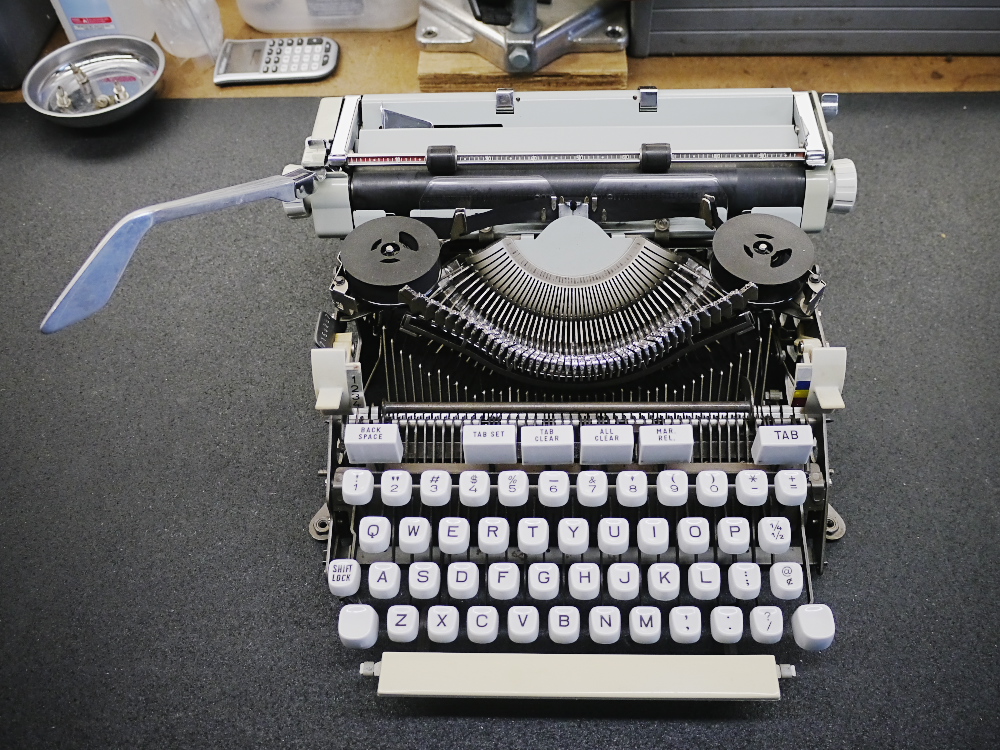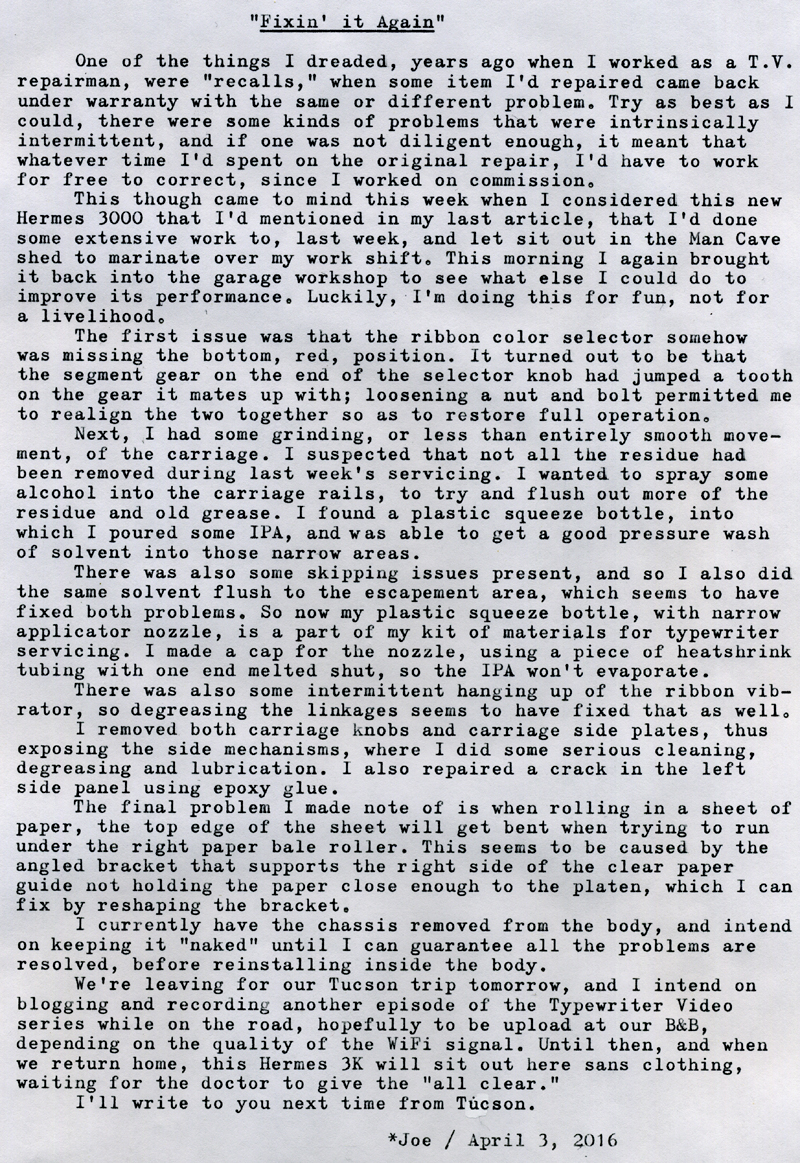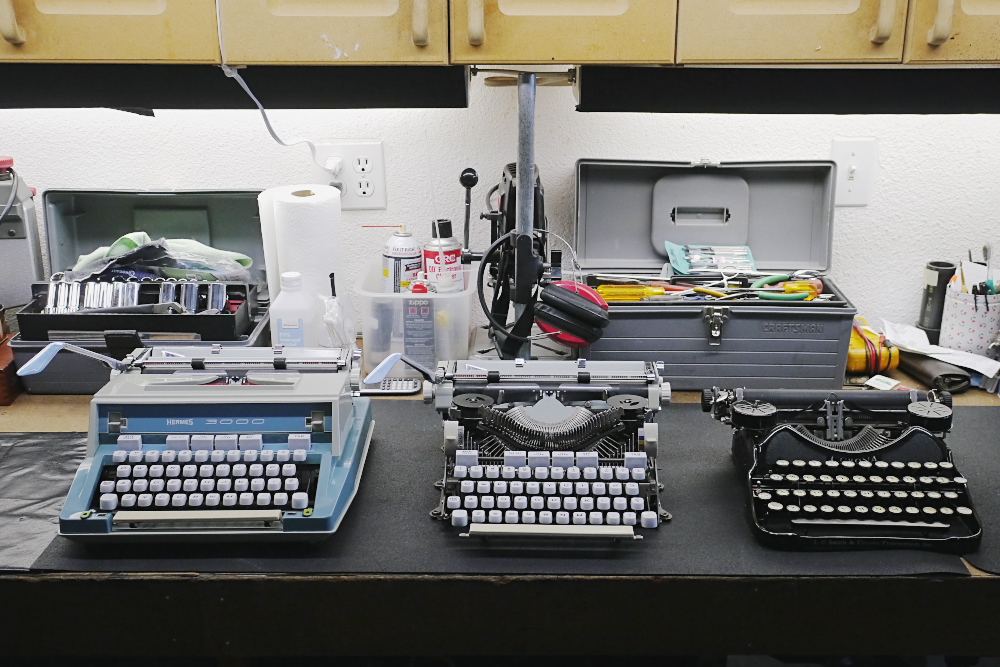Fixin' It Again


Post-Script: One of the things I mentioned several weeks or so ago, after servicing the blue Hermes 3000, was the possibility of leaving it as a "naked" or "chopped" typewriter. I've since reconsidered that idea, at least for the blue one, because I really do like the color of its body. However, consider this:

Ya' see that? Hold onto your hats! The fully-clothed blue Hermes is on the left; my small Corona 4 is on the right; while dead-center in the middle is this more recently acquired Hermes 3000, same body style and era as the blue one, but sans clothing. Now don'tcha go drooling all crazy-like over her pretty frame and intimate parts, because that would be unseemly, and this here's a family-oriented blog. But do notice this: how much more diminutive she looks when, er, less fully clad, dressed only in her birthday suit, so-to-speak like. Now imagine she was mounted (easy there, pardner...) to a nicely finished piece of fine hardwood as a base, not too big of a base, just enough to offer proper support ('cause a gal's gotta have support, you do understand?), but not so big as to make her appear more bulky than she really is, underneath all that fine 1970's-era plastic paneling.
Since I intend on keeping her chassis (and what a fine chassis it is...) exposed for at least a week, so as to verify all the bugs are ironed out before reinstalling the body panels (which doing so is tricky, and involves bending pieces that could easily, if done one too many times, break), this will give me some time to consider the "chopped" typewriter look as an alternative. If I do opt for this form of presentation, it would seem necessary to fashion some sort of custom plywood box to fit her in, when not in use, to keep her clean and also to provide for more convenient transport. Keep in mind that, other than the Corona 4, I don't normally display my typewriters; rather, I keep one or two out for actual use.
I'm thinking of a thin-walled plywood box that opens on the front end, permitting the chassis, still mounted to the base, to be slid inside and the base secured inside the box, with the front lid then latched close, with a carrying handle (or strong leather strap?) provided. Nothing too fancy, just basic, simple woodworking to give it a utilitarian appearance to go with the industrial look of the bare mechanical chassis.
You might have noticed that the quality of imprint, as seen in this typecast, has indeed improved since the last article; I now cannot find one fault with its operation, which is as it should be, given the fine engineering of these machines.
For those of you with queasy stomachs, I'd purposefully not mentioned in the previous article that some of the many "particulates" clogging the insides of this machine involved the residue of insects, and insect parts. Yes, I know, it sounds disgusting, which it is. But consider this: back in the 1980s, when I was a consumer electronics technician, I recall one time opening a VCR on my bench (I can still remember the brand and model number: a Mitsubishi HS-330R; that's how vivid it still is), and I immediately notice, along with the - ahem - "aroma," were "things" moving around inside the circuit boards and mechanical transport. Yes, it didn't take me too many microseconds to slap the cover back on and high-tail it out to the back porch of the shop, where we had an air compressor, and I commenced blowing out the little creepy-crawly insects. I can only imagine what the apartment looked like where this machine resided. But that was one of the more fun aspects of servicing consumer electronics; so in retrospect, this typewriter was rather tame by comparison.
Barring any unforeseen Internet connectivity issues, I should at the very least be able to blog from Tucson, but hope to also upload to YouTube another installment of the Typewriter Video Series.
Labels: Hermes, Hermes 3000

2 Comments:
Have fun in Tucson! I hope you do build a nice wooden case for the exposed 3k.
I note that a lot of 1970's machines could be improved by not-so-roomy shells. I really kind of wonder if the guts of a Safari might actually fit perfectly in the shell of a 1950's QDL? Polt proved the SM9 would drop into an SM3 shell, and everyone knows just about any Olivetti portable made after 1964 will interchange shells.. wonder how many other brands are like this. I might try to drop an old 50's Super-5 into a Galaxie shell sometime, just to see if it works. Maybe a Franco-3k will fit into the curvy 1960's 3k shell too? :D
You could at least put a towel around her till you get back! ;)
Post a Comment
<< Home